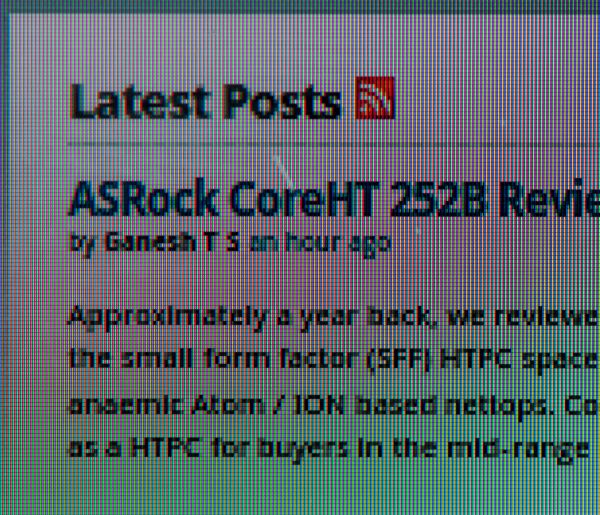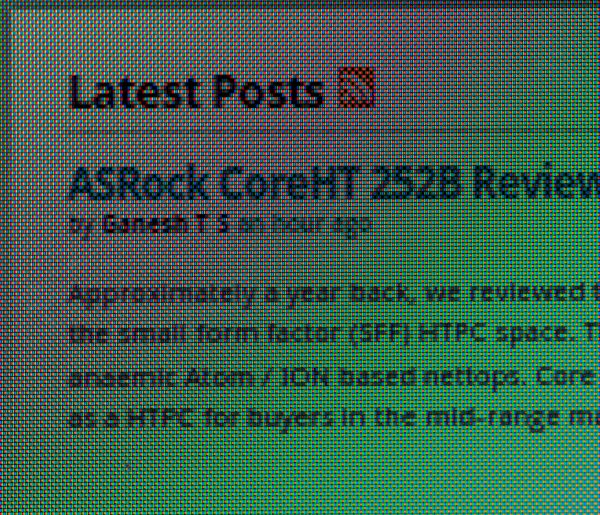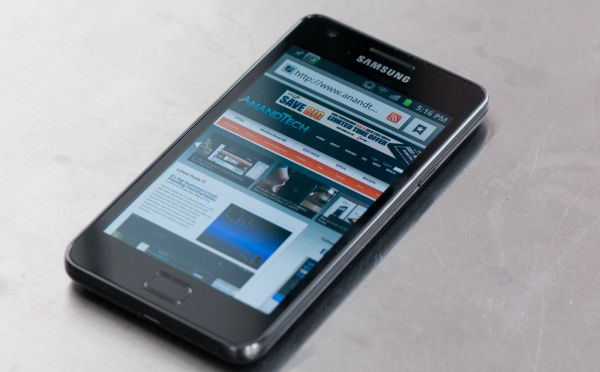Samsung Galaxy S 2 (International) Review - The Best, Redefined
by Brian Klug & Anand Lal Shimpi on September 11, 2011 11:06 AM EST- Posted in
- Smartphones
- Samsung
- Galaxy S II
- Exynos
- Mobile
Display
One of the highlights of SGS2 is its 4.3“ SAMOLED+ display, which we’ve seen before on phones like the Droid Charge, and a 4.5” version of on the Samsung Infuse 4G. Though the panel is the same as what we’ve seen in the past, the controller and software are different.
As a quick refresher, Samsung has now passed through three variants of AMOLED. The first was straight up AMOLED which we saw on phones like the Nexus One and Incredible in a 3.7“ WVGA format with RGBG PenTile. The next was Super AMOLED, which was 4.0” WVGA with PenTile and adorned Galaxy S. The main improvements with Super were integration of the digitizer with top glass and use of optically transparent adhesive to reduce air gaps and subsequent fresnel reflections that add glare and reduce transmissivity. The net effect of that was improved outdoor readability and potentially some power savings from losing less light to back reflections.


Left: Super AMOLED Plus, Right: Super AMOLED
So now we’re up to Super AMOLED Plus (SAMOLED+), so what does this add? Well first, size is now 4.3“ or 4.5” (depending on what tickled some carrier’s fancy), and resolution is still WVGA (800x480), but the big change is that PenTile RGBG is gone. In its place is a standard RGB stripe. I’ve been rather critical of RGBG PenTile in the past purely because it emulated higher effective resolutions by using fewer subpixels (2 per logical pixel) and as a result had a characteristic grain in some circumstances. On AMOLED especially it wound up being distracting more than it was novel, and on 4" displays, it seemed that subpixels were visible with the naked eye and average visual acuity. Furthermore there were some issues with an offset pattern like RGBG and the UI direction Android was taking. Single pixel wide UI elements, some text, and solid primary colors were the main culprits where RGBG could, without considerable scrutiny, look characteristically grainy.
So why is it gone now? The big reason is probably because a corresponding move to a larger panel increases the size of those subpixels, and no doubt 4.3“ WVGA with PenTile would look even more grainy despite having the same ”effective“ resolution. Four inches was pushing it for a grid that started life at 3.7”, and 4.3“ probably was a step too far. In addition, subpixels are also correspondingly larger in the 4.3” RGB stripe (and the process mature enough now) that certain color subpixels being more prone to failure than others (and this needing to be sized appropriately) should no longer be a concern. Samsung also claims that power drain has been reduced in SAMOLED+ by almost 20% from the previous generation, no doubt partially thanks to fabrication maturity and changes made that come with better understanding of the process.
The same benefits apply with SAMOLED+ as the previous generations though - absolutely black blacks due to the subpixels not emitting any light in the off state, and potentially super vibrant colors (if calibrated properly). Unfortunately the few issues we saw with SAMOLED+ on other phones continues here as well - white point that varies with brightness level, a chance of overheating, and a bit of lingering sharpening.
Let’s start with the first one, which a lot of users have dubbed ‘yellowing’. For a while now we’ve been gathering white point data at various brightness levels. Obviously we did the same thing with SGS2.

I’ve measured brightness (full-screen white and black) and white point at six brightness levels on the SGS2. Before I measured the SGS2, I noted that subjectively there’s the most visible change in color temperature after you dip below the 50% brightness mark. To that extent, I took more measurements below that halfway point. I also tossed in the Samsung Infuse 4G (which we received but didn’t formally review) which has a 4.5" SAMOLED+ display that no doubt is identical to what’s headed to the Sprint and T-Mobile SGS2 variants, though with a different display controller. I also tossed in the Samsung Galaxy S 4G as a SAMOLED data point, and the Nexus One as an AMOLED data point, just so you can see how things have changed over the now 3 generations of AMOLED panels Samsung has shipped.
The data bears out the effect that numerous subjective parties have noticed - SGS2’s display temperature gets warmer at lower brightnesses, and varies between 7328K at 0% brightness and 8600K at 100% brightness. It’s enough of a delta in white point to be unfortunately very visible to the naked eye. There’s also an interestingly large amount of variance between the three SAMOLED+ phones we’ve measured, though the same shape curve is just translated around for the Infuse, the Charge appears to be very blue everywhere. Bear in mind again that the SGS2 uses a different display controller than the previous generation of devices.











132 Comments
View All Comments
kreacher - Monday, September 12, 2011 - link
I was disappointed to see that there is no mention of the screen 's inability to display 24bit gradients while Samsung claims its a screen capable of displaying 16M colors.supercurio - Monday, September 12, 2011 - link
See my answer for Astri.Maybe you only checked a gradient in Web Browser or a specific app that forces 16bit surfaces.
Each app has the ability to choose how the rendering is done in this regard.
Internally, the Super AMOLED controller works in much more than 24bit in order to proceed to complex color-space conversions between the a digital frame buffer and an analog, very large dynamic range OLEDs.
lemmo - Monday, September 12, 2011 - link
Great review, and incredible detail on the audio quality. Shame the SGS2 has taken a step backwards on audio. Any info on the likely spec for the audio on the Samsung Nexus Prime?Also, any recommendations on reviews of best smartphones for audio quality? cheers :)
supercurio - Monday, September 12, 2011 - link
Thanks for the feedback!I really need it in order to improve next review.
Organize it differently for better readability, maybe evaluate other aspects as well (like recording)
I have no info about what's in Nexus Prime but I'd like to :P
If somebody can send me a report: https://market.android.com/details?id=org.projectv... I'll study it.
Best devices I know in terms of audio quality:
- with Voodoo Sound: Nexus S, Galaxy S family, Galaxy Tab 7".
- with or without Voodoo sound: Asus Transformer
- soon with Voodoo Sound: Galaxy Tab 10.1 (incredible power stage for the headphone amp)
- iPhones/iPad: clean DAC but boring headphone amp (unable to drive many cans to adequate levels)
And.. many I don't know! (yet?)
lemmo - Wednesday, September 14, 2011 - link
Thanks supercurio, very helpful. I'll keep looking for more info on the Nexus Prime.Shame none of the other phones/tablets you mention have got the right spec for me.
In practice, do you think the 'average user' will notice the poorer audio quality on the SGS2?
yellowchilli - Monday, September 12, 2011 - link
a very very good read thank youi've owned the sgs2 since its EU launch..it's interesting to see the slight differences/improvements samsung has put into the US release (e.g. the power button, camera ui)
mcquade181 - Monday, September 12, 2011 - link
I've had my SGS2 here in Australia for two months now and on a recent snow trip noticed some deficiencies compared to my friends Nokia N8. We both use the same provider (Telstra 3G on 850MHz):1. Whilst travelling there were periods where I completely lost reception whereas the N8 still had a signal and was able to make calls. This suggests that the SGS2 is a bit lacking in cellular sensitivity (and note that the N8 is not all that flash either when compared to the old Nokia N95).
2. In our snow accomodation I could not get a reliable WiFi signal from the local hotspot whereas the N8 could (it was marginal, but it did work).
3. Bluetooth on the SGS2 is unreliable with some devices. It keeps disconnecting after a few minutes.
That said I do like my SGS2 and is better in many other ways to the Nokia N8 - in particular earphone volume and call clarity where the N8 is deficient. Of course android has a much wider selection of available apps than does the Nokia, although surprisingly ALL my favourite apps are also available for the Nokia.
Regards from down under, Graham Rawolle.
willstay - Monday, September 12, 2011 - link
What a coincidence. After two Androids, I actually bought N8 and later sold it to get SGS2. Before Belle, swype was only available in landscape and my must-have apps are not there for Symbian.jcompagner - Tuesday, September 13, 2011 - link
yes that is the only drawback i also can find of the SGS2..Wifi reception is really not up to standards.
kmmatney - Monday, September 12, 2011 - link
I'm not happy with the battery tests - they don't show real life usage. I'd still like to know what happens with the battery if you just leave the phone in your pocket for most of the day, or what happens if you leave it in standby overnight. All of my co-workers complain about battery life with their Android phones, and all want to get iPhones the next time around. The batteries seem to drain excessively with the phones doing nothing, and they are often dead when they go to use them. Who cares if you can browse the web for 7 hours or whatever...I just want the phone to be ready to use if its been sitting on my desk for half the day, or if I forget to charge it overnight. This is way more important - at least for someone like me who travels. (actually, I work a lot in wafer fabs around the world, and crappy reception in the fabs often drain battery quickly).I guess it will depend on what Apps are installed, and you use push notifications, but it would be useful to have a test where you charge the phone, and then let it sit for 8 hours doing nothing, and then report the battery life. The older Android phones seemed terrible at this, while my iPhone 3GS is great.
This phone looks awesome, but I would need this information before I would consider buying it.